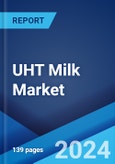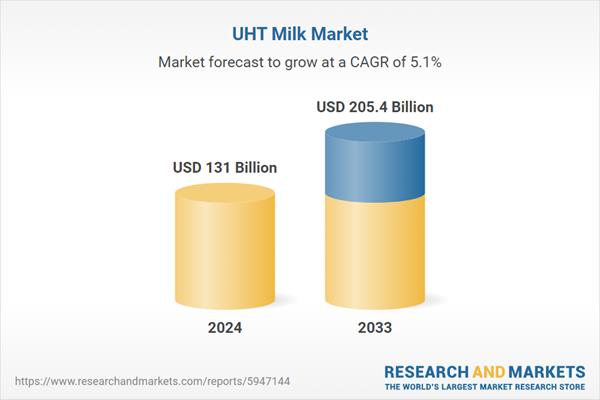Rising Demand for Convenient and Long-Lasting Milk Products Driving the Market
The increasing demand for milk products with an extended shelf-life is the leading factor driving the growth of the global UHT milk market. Hectic lifestyles, longer working hours, and a growing preference for easy-to-use and ready-to-eat products are driving product sales. In addition, the demand is exceptionally high in countries where refrigeration and cold-chain infrastructure is weak or non-existent. In such regions, UHT milk is preferred due to its long life and the ability to be stored at room temperature.Moreover, there is currently a rise in the apartment culture with restricted or little refrigeration space, which is driving the product demand. Apart from this, awareness regarding the benefits of UHT milk over conventional milk has been increasing continuously, driven by an increase in marketing initiatives by manufacturers through various advertising mediums such as newspapers, television, etc. This is also expected to positively impact the global demand for UHT milk.
Competitive analysis such as market structure, market share by key players, player positioning, top winning strategies, competitive dashboard, and company evaluation quadrant has been covered in the report. Also, detailed profiles of all major companies have been provided. The market is dominated by a few major players operating in the industry due to high capital investments and barriers to entering the market. The volume of new entrants is low due to the capital-intensive nature of the UHT milk industry and the requirement of significant investment in technology, processing equipment, packaging, and distribution.
What is UHT Milk?
UHT milk is shelf-stable milk that undergoes sterilization and heating at elevated temperatures. The heating process removes pathogens, bacteria, and other spoilage-causing organisms. The UHT process is different from regular pasteurization, which only heats the milk to a lower temperature and does not make it sterile. UHT milk has a longer shelf life of several months and does not need to be refrigerated until it is opened. It is also a rich source of essential nutrients, including calcium, phosphorus, potassium, riboflavin, zinc, vitamins A and B12, and magnesium. The high temperature during the process also gives it a distinct taste and aroma, which varies depending on the type of milk used.
COVID-19 Impact:
The COVID-19 pandemic led to a surge in demand for UHT milk as consumers stockpiled non-perishable food items due to lockdowns and restrictions on movement. As a result, panic buying and hoarding food products, including UHT milk, caused temporary supply disruptions and increased prices.However, the pandemic also brought significant challenges to the global food supply chain, including the dairy industry. Supply chain disruptions and logistics challenges led to reduced production and distribution capacity. These challenges have impacted the availability and affordability of UHT milk, with many countries experiencing shortages. Significant reliance on the workforce and a complex supply chain have led to production restrictions and, in some cases, closures. Furthermore, the closure of milk collection centers led to a shortage of raw milk for the production of UHT milk.
As a result of the pandemic-related constraints on goods transportation, road movement restrictions, rising production expenses, shortage of operating capital, and labor scarcity, numerous businesses suffered losses. Nonetheless, the growing consumer demand for UHT milk attracted a slew of new participants to the UHT milk market segment.
UHT Milk Market Trends:
The inflating disposable incomes and rising urbanization in developing countries are among the key factors driving the demand for UHT milk. In addition, as people move to cities and adopt more modern lifestyles, the need for convenience and RTD products is increasing.Apart from this, advancements in UHT milk processing technology are also driving the growth of the market. Modern technologies, such as aseptic packaging, have improved the efficiency and effectiveness of UHT milk processing, leading to higher-quality products and reduced costs. Additionally, the development of new flavors and packaging designs has expanded the range of UHT milk products available to consumers with diverse preferences. Moreover, key vendors are introducing new products at lower prices to attract consumers from low economic groups.
Furthermore, government support and investments in the dairy industry are also contributing to the market growth. Many governments across the globe are providing subsidies, grants, and other incentives to promote dairy farming and processing. Additionally, initiatives to improve the cold-chain infrastructure and logistics are expected to boost the availability and affordability of UHT milk in many regions.
Key Market Segmentation:
The publisher provides an analysis of the key trends in each sub-segment of the global UHT milk market report, along with forecasts at the global and regional level from 2025-2033. Our report has categorized the market based on type and distribution channel.Type Insights:
- Whole
- Semi-Skimmed
- Skimmed
Distribution Channel Insights:
- Supermarkets and Hypermarkets
- Convenience Stores
- Specialty Stores
- Online Retail
- Others
Regional Insights:
- European Union
- Asia
- North America
- Latin America
- Eastern Europe
- Middle East and Africa
Competitive Landscape:
The report has also provided a comprehensive analysis of the competitive landscape in the global UHT milk market.Some of the companies covered in the report include:
- Lactalis International
- Nestlé S.A.
- Fonterra Co-operative Group Limited
- Danone S.A.
- Arla Foods Amba
- Royal FrieslandCampina N.V.
- Dairy Farmers of America Inc.
- Saputo Inc.
- Dean Foods
- Yili Group
Key Questions Answered in This Report
1. What was the size of the global UHT milk market in 2024?2. What is the expected growth rate of the global UHT milk market during 2025-2033?
3. What has been the impact of COVID-19 on the global UHT milk market?
4. What are the key factors driving the global UHT milk market?
5. What is the breakup of the global UHT milk market based on the type?
6. What is the breakup of the global UHT milk market based on the distribution channel?
7. What are the key regions in the global UHT milk market?
8. Who are the key companies/players in the global UHT milk market?
Table of Contents
Companies Mentioned
- Lactalis International
- Nestlé S.A.
- Fonterra Co-operative Group Limited
- Danone S.A.
- Arla Foods Amba
- Royal FrieslandCampina N.V.
- Dairy Farmers of America Inc.
- Saputo Inc.
- Dean Foods and Yili Group
Methodology

LOADING...
Table Information
| Report Attribute | Details |
|---|---|
| No. of Pages | 129 |
| Published | January 2025 |
| Forecast Period | 2024 - 2033 |
| Estimated Market Value ( USD | $ 131 Billion |
| Forecasted Market Value ( USD | $ 205.4 Billion |
| Compound Annual Growth Rate | 5.1% |
| Regions Covered | Global |
| No. of Companies Mentioned | 9 |









